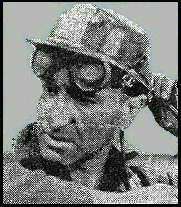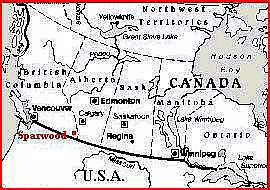|
This page is a tribute to the men who lost their lives in
the
April 3, 1967 explosion in the
Balmer North coal
mine. The Balmer North mine was located in the historic Canadian
coal mining towns of Michel - Natal, British Columbia
. These two towns were established around 1900. In the
late 1960's the towns were relocated to the nearby community of
Sparwood.
This is a picture of the men who died that fateful day
The names and ages of the victims:
Top Row:
Eugene Lucky, 27;
Mike Bryan, 64;
Archie Wojtula, 44; Ronald Frenz
, 31;
Delfie Quarin, 37.
Middle Row: Sam Tolley, 53;
Hugh Hopley, 36;
Guy Venzi, 58;
John Brenner, 46; Willie DeLorme
, 19.
Bottom: Wladuslaw "Walter" Gibalski, 53;
Walter Parker, 27;
Eric Lutzke, 38;
Antanas "Tony" Cepeliauskas, 65; Bill Cytko
, 41.
Coal mining has always been a dangerous way to make a living.
When men are working underground extracting coal, the earth
needs to work or settle as the tunnels proceed. If this
does not occur then there is continuous movement which can
cause the roof to collapse. In addition, there is a
constant bleeding
off of the coal gas (methane)
which can accumulate in the
shaft. When the concentration of methane gas reaches
a range of 5.8% to 13.3%, an explosion becomes a possiblity. If
at this point, there is an ignition source, such as an
electrical spark, an explosion will likely occur.
In addition, one final contribution to a disaster,
is the coal dust which
always permeates the tunnels. When methane gas
explodes, the fine coal dust gets disturbed and flies up
into the air and also ignites, causing a huge explosion
to occur along the whole length of the tunnel. This is the
same type of thing that occurs in grain elevators where
there is also a lot af dust.
To this day, we still do not know for sure what exactly
caused the Balmer North Mine to explode.
The explosion in the Balmer North Mine
occurred at 4:00 P.M.
just as the day shift had left and
the afternoon shift was arriving for work. If it had
happened an hour sooner or even a half an hour later the
number of fatalities could have been much higher. There were
approximately thirty miners had just entered the tunnel when
the blast occurred. Thirteen of them were either killed
outright or died later of their injuries. It has been said
that the tunnel shape may have saved some as there was a
sharp angle about 1000 feet in and the blast, as it rushed
out of the tunnel began to ricochet down the shaft and
therefore missed some and caught the others. Fortunately,
the Mine Rescue team was starting to practice and were all
suited up and ready to go when the accident occurred. They
immediately raced to the mine site to begin the rescue
effort.
There were 10 men seriously injured by the
explosion.
They were:- Larry Savilow,
Earl Price,
Bob Brown, Gerry Clark,
Herb Parsons,
Art Parsons,
Pete Rotella, William Corrigan
, Robert Clegg,
and
Irv Mitchell.
Pete Rotella was actually
blown out of the mine entrance over an embankment 150 feet
away. Amazingly, he was probably the least seriously
injured of the men. The injured were being transported to
the hospital in any way possible as there was only one
ambulance in the town.
The resources of the small Michel hospital were taxed to the
limits with all the injured miners arriving. All kinds
of help began to arrive in the form of doctors, nurses, and
ordinary people who wanted to help in whatever way they could.
As well, Mine Rescue teams came from the south-eastern B.C.
towns of Fernie and Kimberley.
Local
businesses donated food and other supplies to help everyone
get through the night. My mother, Helen Venzi
, was working at the hospital and remembers
the horror of seeing all these injured men she knew covered
with mud and unrecognizable except by their voices.
From now on these men carried the coal dust stained blue
scars on their faces which branded them as survivors of
this terrible experience.
Once the survivors injured near the mine entrance were
removed, the grisly task now confronting the Mine Rescue
team was to search for the other two missing miners,
Delfie Quarin and
Guy Venzi, my uncle. They were the only
ones who were actually deep in the mine when the blast occurred.
My cousin, Ernie Borsato, and my
neighbour, David Howe, were
members of the Mine rescue team. I recall David Howe
telling me the feeling of wanting to find Guy and Delfie
but not wanting to find them as they knew they could not
have survived. David also described how, when underground,
he felt like gagging, but could not remove his mask, due to
poisonous gases in the mine.

|
This is a picture of Ernie Borsato
, a member of the
Mine Rescue team. He is about to enter the mine to search for
the two miners still unaccounted for -- my uncle Guy
Venzi and Delfie Quarin.
Guy and Delfie had stayed behind to repair some machinery when the
rest of the day shift left. Guy was Ernie's uncle too. This picture
captures the strain that Ernie and the rest of the Mine Rescue teams
were under. The bodies of Guy and Delfie were not found
until six o'clock the next morning.
|
The memory of that day is still quite vivid in
my mind's eye even though I was away at university at the
time. I heard a news flash on the radio and when it
mentioned a "mining accident" it spurred my attention
immediately. I knew that my Uncle Guy
worked in that mine and
due to the emergency there was no way for me to contact
anyone over the phone. I did not learn of my Uncle Guy's
death until the next morning when his name was
announced on the radio.
Guy Venzi was not my first relative to die in the mines. Another
of my uncles, Mike Borsato,
died in a gas related accident in 1951.
As a child growing up in Michel, I had watched the ambulance
go to the hospital
many times. Each time, I had heard my
parents, Fred and
Helen Venzi, speak of
other miners who had died on the job. I also recall the
fear I felt as my
own father would go to work in the mine. It seemed
especially foreboding when he left the house on his
night shift.
Although all the miners
worked hard in dangerous conditions, they had some fun
too. After work, they would often talk of the pranks they
played on each in the mine. They developed
a camaraderie that is hard to describe, and most of them
would not have wanted to work at anything else.
These fifteen men who died on April 3, 1967, along with all
the others,
who have lost their
lives in the "dark recess" of all the coal mines of the
Michel-Natal area deserve to be remembered in a special way
by those of us that remain.
My HOMEPAGE
Coal Miners Memorial
is a tribute to the miners
of the Natal-Michel and Sparwood area of British Columbia, Canada.
It also has coal-mining Links.
My COMPANION PAGE
Hillcrest Mine Disaster commemorates the 189 men
killed in Canada's worst coal mining disaster which occurred
in 1914.
Written by:
Ron Venzi
Calgary, Alberta, Canada
Email: ronvenzi@hotmail.com
|
